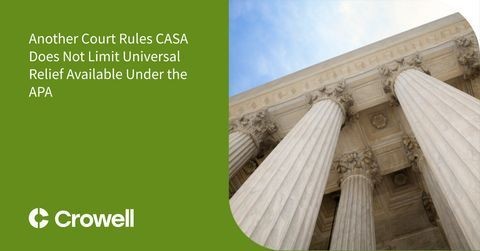COFC Dismissal Order Highlights the Pre-Litigation Traps and Timeliness Bars of Section 1498 Claims
Client Alert | 3 min read | 11.17.21
The U.S. Court of Federal Claims recently dismissed most, but not all, claims of patent infringement brought by JG Technologies, LLC relating to the detection of stealth objects. At issue were four claimed categories of infringement: (1) aircraft detection, (2) passive detection, (3) autonomous vehicles, and (4) vehicle collision detection. In a decision reaching many different issues, from statute of limitations to subject-matter jurisdiction to tolling, only some of the Plaintiff’s claims survived; the Court dismissed the rest. This case is a good reminder of the sometimes-complex pre-litigation procedures a patent owner must follow in order to perfect a § 1498 claim for patent infringement.
The patent in question, United States Patent No. 7,952,511 (the ‘511 patent), covers the detection of many different objects such as cars, drones, and aircraft over greater distances than existing methods. The patent application was placed under a secrecy order by the United States Patent and Trademark Office at the request of the Air Force from 2002 to 2009. In 2008, the inventor filed a claim with the Air Force seeking damages resulting from the secrecy order, which the Air Force denied in 2013. The inventor failed to appeal the denial of that claim. Six years later, in 2019, the inventor filed a second claim for infringement, which the inventor subsequently amended to comply with the Defense Federal Acquisition Regulation Supplement (“DFARS”) Requirements. Shortly thereafter, the inventor filed suit at the Court of Federal Claims accusing the Government of infringing the ‘511 patent, and then amended its complaint to include the contract between government agencies and a company called Thruvision.
On the Government’s motion, the Court first dismissed the Plaintiff’s aircraft detection claims on statute of limitations grounds. While the Plaintiff argued it was entitled to 1,823 days of tolling for the period between the inventor’s 2008 claim for damages resulting from the secrecy order and the Air Force’s 2013 denial of that claim, the Court disagreed. The inventor had failed to appeal the Air Force’s denial of that claim. Moreover, that claim was for damages resulting from the secrecy order, not for infringement of the patent, which was not even issued until 2011, years after the original claim was filed. Further, even the subsequent claim for infringement, initially filed in 2019, did not toll the statute of limitations until the inventor perfected that claim by filing a subsequent declaration in 2020 to comply with the relevant DFARS requirements. Based on this 2020 date, the inventor was only entitled to 85 days of tolling. Accordingly, the related infringement claims fell outside of the six-year statute of limitations for an action under 28 U.S.C. § 1498(a). The Court also rejected the Plaintiff’s argument for tolling based on the Government’s “secret use” because the Plaintiff presented only conclusory allegations to support its claim that there was a “secret use” in the first place.
The Court also dismissed the Plaintiff’s passive detection claims that preceded 2014, since any claims before that date were outside the Court’s jurisdiction for statute of limitations purposes. For those that post-dated 2014, though, the Court found that the Plaintiff had sufficiently pled a claim for relief because infringement does not need to be pled element by element. Instead, the Court found, “reciting the claim elements and merely concluding that the accused product has those elements” would be sufficient. The Plaintiff’s citation to an article on the use of passive scanners by the TSA and a PowerPoint demonstrating the Army and Air Force as customers of Thruvision, while not specifying exact make and model numbers of infringing equipment, sufficiently put the government on notice.
Finally, the Court dismissed the remaining autonomous vehicle and vehicle collision detection claims to the extent they were based on services performed in a foreign country, which are outside the scope of a §1498 action. Thus, equipment donated to the Peruvian government fell outside of the jurisdiction of the Court. However, the Customs and Border Protection call order that started in the United States and was subsequently donated to the Mexican government was within the Court’s jurisdiction.
Contacts
Insights
Client Alert | 3 min read | 01.05.26
Another Court Rules CASA Does Not Limit Universal Relief Available Under the APA
In Trump v. CASA, the Supreme Court significantly constrained the equitable authority of federal district courts to grant universal or nationwide injunctive relief, clarifying that, with specific exceptions, a federal court’s power to grant relief is limited to the parties before it. When it was issued, many bemoaned CASA’s implications for preventing government overreach.
Client Alert | 7 min read | 01.05.26
Consideration of Artificial Intelligence in Arbitration Terms of Reference
Client Alert | 4 min read | 12.31.25
Raising the Bar: New York Expands Consumer Protection Law with FAIR Business Practices Act
Client Alert | 4 min read | 12.30.25




